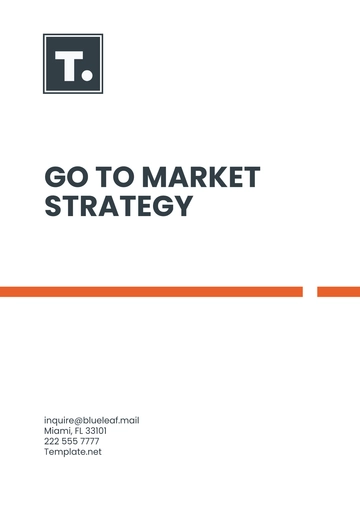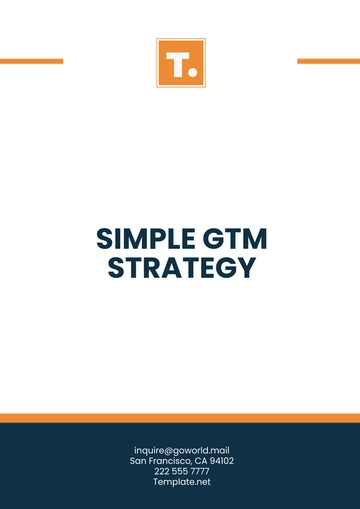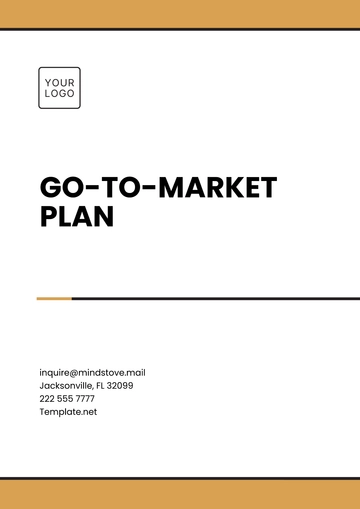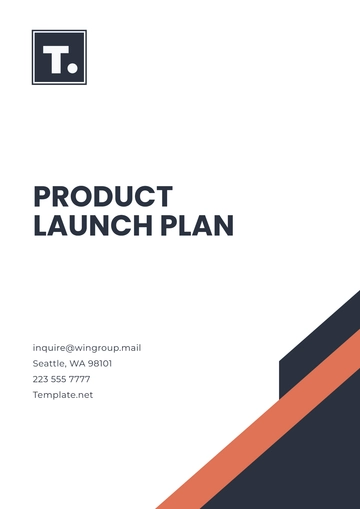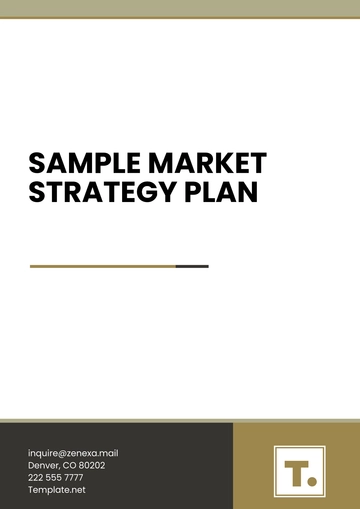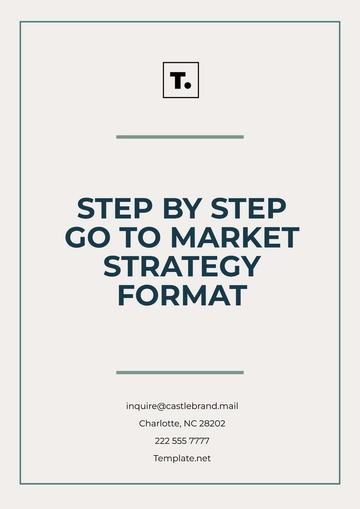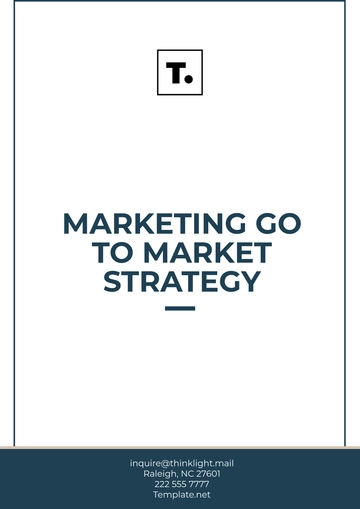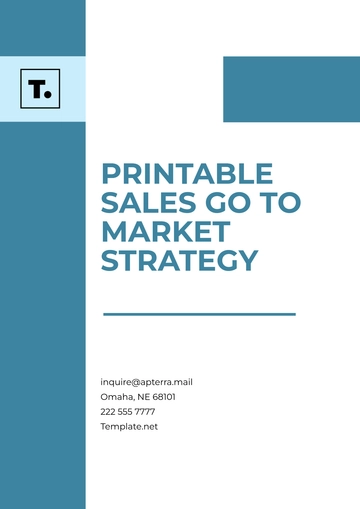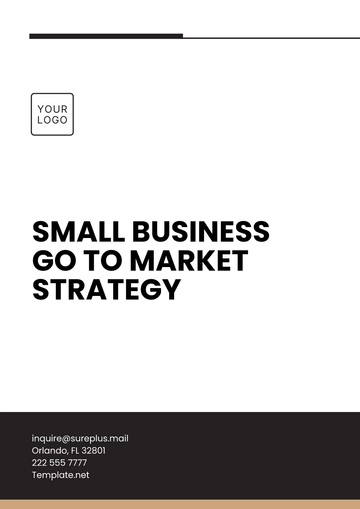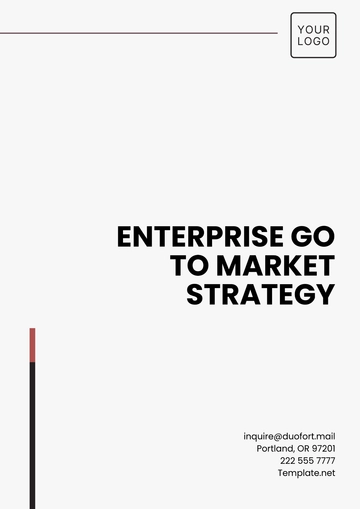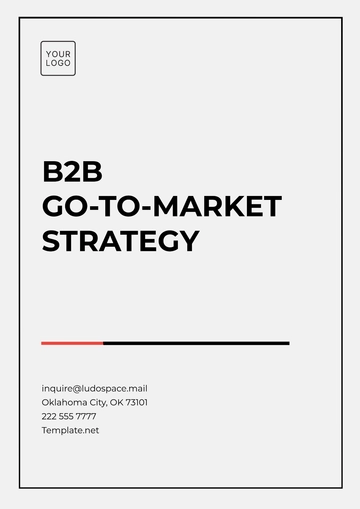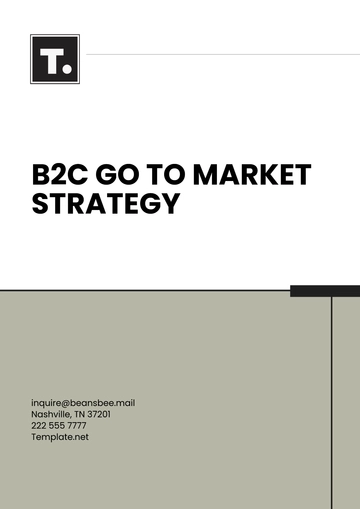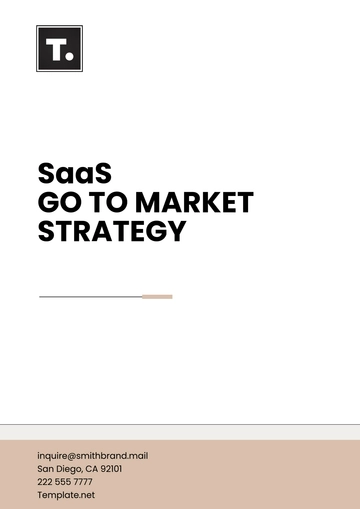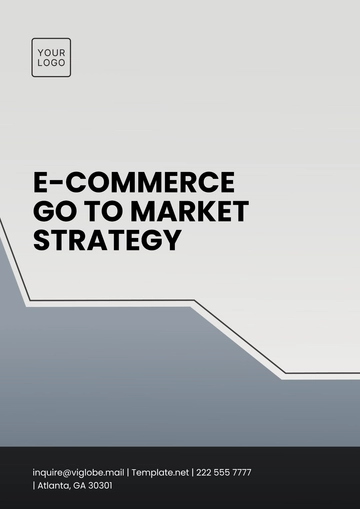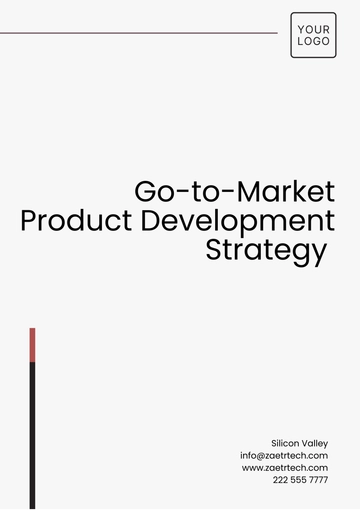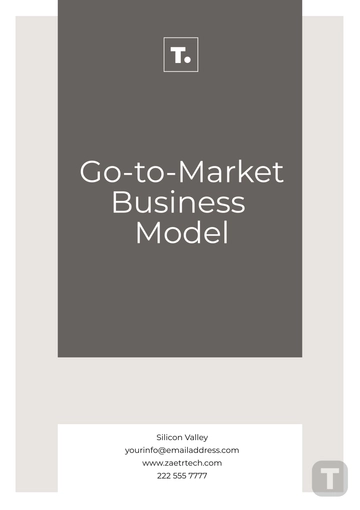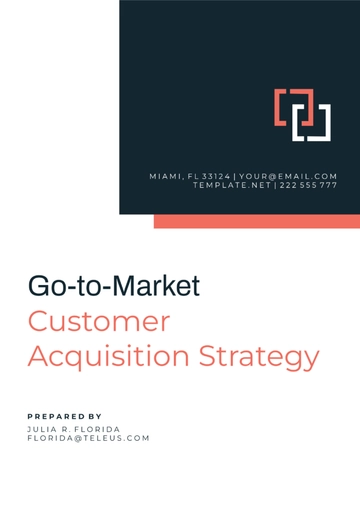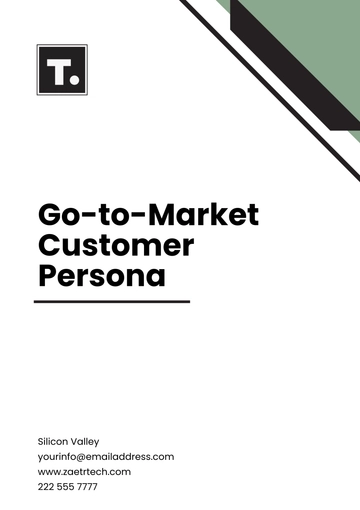Free Go-to-Market Customer Persona

Creating a Go-to-Market (GTM) Customer Persona is a vital step for [Your Company Name] in understanding our target audience, tailoring our marketing strategies, and maximizing the efficiency of our product offerings. In the year [2050], the landscape of consumer behavior has undergone significant changes due to advancements in technology, shifts in social norms, and evolving market dynamics. Understanding these changes is crucial for [Your Company Name] to effectively connect with our customers and drive growth.
1. Introduction to Customer Persona
A customer persona, often referred to as a buyer persona, is a semi-fictional representation of our ideal customer based on data, insights, and thorough research. It encapsulates various aspects of customer demographics, behaviors, goals, and pain points, providing [Your Company Name] with a clear and actionable framework to guide its marketing strategies.
1.1 Purpose of the Customer Persona
The primary purposes of creating a customer persona for [Your Company Name] include:
Guiding Product Development: A well-defined customer persona allows the product development team to create products that address specific needs, solve relevant problems, and enhance the overall customer experience. Understanding what customers value helps prioritize features and functionalities in new product offerings.
Tailoring Marketing Strategies: With insights from customer personas, [Your Company Name] can design marketing messages that resonate with different audience segments. Tailored marketing strategies lead to higher engagement rates, better conversion metrics, and overall enhanced customer satisfaction.
Improving Customer Engagement: By knowing the characteristics of our personas, [Your Company Name] can craft personalized experiences that foster customer loyalty. Engaging customers in ways that matter to them results in increased brand affinity and repeat purchases.
Aligning Sales Strategies: Sales teams equipped with knowledge about customer personas can better identify their targets, enabling them to create more effective outreach strategies. Understanding who to approach and how to communicate with them increases the chances of closing deals and building long-term relationships.
2. Overview of the Target Market
Understanding the broader target market is essential for developing specific customer personas. The following table outlines key market segments for [Your Company Name] in [2050]:
Market Segment | Description | Size (in millions) | Growth Rate (%) |
|---|---|---|---|
Tech-Savvy Consumers | Individuals who adopt new technology quickly. | [200] | [15%] |
Health-Conscious Users | Customers prioritizing wellness and health. | [150] | [10%] |
Eco-Friendly Shoppers | Consumers focused on sustainable products. | [100] | [12%] |
Remote Workers | Professionals working from home or hybrid setups. | [180] | [20%] |
2.1 Market Trends
Understanding market trends is critical for [Your Company Name] to anticipate customer needs and adjust our strategies accordingly. Key trends impacting our market include:
Technological Advancements: The proliferation of Artificial Intelligence (AI), the Internet of Things (IoT), and 5G technologies have transformed consumer expectations regarding product functionalities and services. Customers now seek seamless integration of technology into their daily lives, leading to increased demand for smart devices and applications that enhance convenience and efficiency.
Sustainability: There is an increasing demand for eco-friendly products as consumers become more environmentally conscious. This shift is driven by a growing awareness of climate change and a desire to support companies that prioritize sustainability. Customers are willing to pay a premium for products that are ethically sourced and environmentally friendly.
Personalization: Customers increasingly expect personalized experiences tailored to their individual needs and preferences. Advanced analytics and data-driven marketing strategies allow companies to deliver targeted content, product recommendations, and customized interactions that enhance customer satisfaction and loyalty.
Health and Wellness: A significant portion of the population is prioritizing health and wellness in their purchasing decisions. This trend has resulted in a surge in demand for products that promote physical and mental well-being, including fitness-related technologies, supplements, and organic food options.
3. Key Customer Personas
To effectively cater to our target market, [Your Company Name] has identified several key customer personas. Each persona represents a distinct segment of our target audience, characterized by specific demographics, psychographics, and behaviors.
3.1 Persona Name: Tech-Savvy Tanya
Demographics:
Age: [28-35]
Gender: Female
Location: Urban areas with access to advanced technology (e.g., New York, San Francisco, Tokyo).
Education: Bachelor’s or Master’s degree in technology, business, or related fields.
Income: $[80,000] - $[120,000] annually.
Psychographics:
Personality Traits:
Early adopter of technology who is always on the lookout for the latest innovations.
Values innovation and convenience, often prioritizing products that enhance efficiency.
Seeks efficiency in daily life and enjoys tools that simplify tasks.
Interests:
Interested in the latest tech gadgets, emerging software, and applications that streamline daily activities.
Actively participates in tech forums and online communities to discuss new trends.
Follows tech influencers and blogs to stay updated on industry developments.
Behavior Patterns:
Buying Habits:
Frequently shops online for the latest technology and digital solutions.
Looks for reviews, user testimonials, and expert opinions before making purchasing decisions.
Often participates in beta testing for new products, providing feedback to companies.
Media Consumption:
Engages with digital content, including blogs, podcasts, and YouTube videos that focus on technology and innovation.
Active on social media platforms such as Twitter, LinkedIn, and Instagram, following tech brands, influencers, and industry news.
Goals and Challenges:
Goals:
Stay ahead of tech trends by discovering and utilizing cutting-edge technology.
Enhance personal productivity through innovative tools and applications that streamline tasks.
Build a network of like-minded individuals and industry professionals to share knowledge and resources.
Challenges:
Overwhelmed by the sheer volume of tech options available in the market, making decision-making difficult.
Concerned about data privacy and security when adopting new technologies and applications.
3.2 Persona Name: Health-Conscious Henry
Demographics:
Age: [35-50]
Gender: Male
Location: Suburban and urban areas, often near health-conscious communities (e.g., Boulder, Austin).
Education: Bachelor’s degree or higher in health sciences, nutrition, or a related field.
Income: $[70,000] - $[110,000] annually.
Psychographics:
Personality Traits:
Values health and wellness as a core component of his lifestyle.
Seeks a balance between work and personal life, prioritizing activities that promote well-being.
Open to trying new health trends and diets that can enhance physical and mental health.
Interests:
Engages in outdoor activities such as hiking, biking, and participating in community sports events.
Interested in nutrition and dietary trends, often seeking new recipes and health tips.
Follows health-related blogs, podcasts, and social media channels that align with his interests.
Behavior Patterns:
Buying Habits:
Prefers organic and locally sourced products that promote sustainability and health.
Invests in health and fitness gadgets, such as fitness trackers, smart scales, and health monitoring apps.
Seeks products that align with a healthy lifestyle, often looking for recommendations from trusted sources.
Media Consumption:
Regularly reads health and wellness blogs, focusing on articles that provide actionable advice and insights.
Listens to health-focused podcasts, enjoying interviews with experts and discussions on current trends in wellness.
Engages with influencers on social media who promote healthy living and fitness.
Goals and Challenges:
Goals:
Maintain optimal health and fitness levels through regular exercise and nutritious eating.
Inspire others in his community to adopt healthier lifestyles through education and shared experiences.
Stay informed about the latest health trends, products, and scientific findings that can benefit his well-being.
Challenges:
Navigating misinformation in the health and wellness space, which can lead to confusion and skepticism.
Finding reliable products that genuinely promote health benefits and align with his values.
3.3 Persona Name: Eco-Conscious Ella
Demographics:
Age: [25-40]
Gender: Female
Location: Urban areas with strong environmental initiatives (e.g., Seattle, Vancouver).
Education: Degree in environmental studies, social sciences, or a related field.
Income: $[50,000] - $[90,000] annually.
Psychographics:
Personality Traits:
Passionate about environmental sustainability and social responsibility.
Values ethical consumption and seeks to support brands that prioritize eco-friendly practices.
Often participates in community initiatives focused on environmental causes, such as clean-up drives and advocacy campaigns.
Interests:
Enjoys DIY projects that promote sustainability and minimize waste.
Actively participates in local conservation efforts and educational workshops.
Follows brands and organizations that align with eco-friendly values on social media.
Behavior Patterns:
Buying Habits:
Researches products extensively to ensure they are sustainable, ethically sourced, and environmentally friendly.
Willing to pay a premium for eco-friendly products that contribute positively to the planet.
Prefers shopping at local businesses and farmers' markets that prioritize sustainability.
Media Consumption:
Engages with content focused on sustainability, eco-friendly products, and lifestyle choices through blogs, videos, and documentaries.
Follows environmental influencers and activists on social media platforms for inspiration and tips on living sustainably.
Goals and Challenges:
Goals:
Advocate for a sustainable lifestyle, encouraging friends and family to make eco-friendly choices.
Stay informed about new developments in sustainable products and practices.
Actively reduce her carbon footprint and contribute positively to environmental conservation.
Challenges:
Encountering greenwashing—where brands falsely claim eco-friendliness—makes it difficult to identify truly sustainable products.
Balancing affordability with the desire to purchase eco-friendly products, as they often come with higher price points.
3.4 Persona Name: Remote Worker Rick
Demographics:
Age: [30-45]
Gender: Male
Location: Varied (may live in urban, suburban, or rural areas) but works for companies based in urban centers.
Education: Bachelor’s degree in business, technology, or a related field.
Income: $[60,000] - $[100,000] annually.
Psychographics:
Personality Traits:
Values flexibility and work-life balance, often seeking opportunities that allow remote work.
Struggles with maintaining boundaries between work and personal life while working from home.
Eager to improve productivity and efficiency in a remote work environment.
Interests:
Interested in home office setups, tools, and technologies that enhance productivity.
Engages in online communities and forums focused on remote work best practices and strategies.
Enjoys outdoor activities and hobbies that provide a mental break from work.
Behavior Patterns:
Buying Habits:
Invests in ergonomic office furniture, tech gadgets, and productivity-enhancing tools to create an optimal home office.
Researches and compares various productivity software and collaboration tools before making purchases.
Frequently purchases digital products and services that support remote work, such as project management software.
Media Consumption:
Consumes content related to remote work, productivity tips, and mental well-being through blogs, podcasts, and webinars.
Follows productivity influencers and industry leaders on social media platforms for advice and inspiration.
Goals and Challenges:
Goals:
Achieve a better work-life balance while maintaining high productivity levels in a remote setting.
Develop a comfortable and functional home office that enhances focus and efficiency.
Cultivate professional relationships and networking opportunities despite working remotely.
Challenges:
Facing distractions at home that hinder productivity and focus, leading to work-life imbalances.
Experiencing feelings of isolation and disconnection from colleagues due to a lack of face-to-face interactions.
4. Customer Pain Points
Understanding the pain points of our customer personas is critical for [Your Company Name] to tailor solutions that resonate with their needs. The following table outlines the primary pain points for each persona:
Persona Name | Pain Points | Impact on Customer Experience |
|---|---|---|
Tech-Savvy Tanya | Overwhelmed by product choices | Difficulty in making informed decisions leads to frustration. |
Health-Conscious Henry | Confusion due to misinformation on health products | Skepticism towards product claims affects purchase intent. |
Eco-Conscious Ella | Limited availability of affordable eco-friendly products | Frustration over inability to find sustainable options. |
Remote Worker Rick | Distractions while working from home | Decreased productivity and increased stress levels. |
4.1 Addressing Pain Points
To effectively address these pain points, [Your Company Name] should consider the following strategies:
Tech-Savvy Tanya: Develop user-friendly comparison tools and guides to simplify product choices. Additionally, offer exclusive access to expert reviews and personalized recommendations based on her preferences. Hosting webinars with tech experts can further engage her by providing insights on the latest innovations.
Health-Conscious Henry: Provide clear and concise information regarding health trends and product benefits. Establish partnerships with trusted health influencers to promote transparency and credibility. Hosting educational workshops on health and wellness can also empower him with knowledge to make informed choices.
Eco-Conscious Ella: Introduce affordable eco-friendly product lines while promoting them through community engagement initiatives. Create content that educates customers on the importance of sustainability. Launching campaigns that showcase the impact of choosing eco-friendly products can resonate well with her values.
Remote Worker Rick: Offer tips and resources for creating an efficient home office environment. Develop and promote productivity-enhancing tools tailored to remote workers. Providing resources such as online courses on time management and focus techniques can enhance his remote working experience.
5. Customer Journey Mapping
Mapping the customer journey allows [Your Company Name] to identify touchpoints and opportunities for engagement throughout the customer lifecycle. Understanding each stage of the journey is crucial for designing effective marketing strategies.
5.1 Awareness Stage
In this stage, potential customers become aware of [Your Company Name] and its offerings. Key activities include:
Content Marketing: Creating informative blog posts, videos, and social media content that address the interests and pain points of each persona. Engaging content such as how-to guides and industry news can capture the attention of prospective customers.
SEO Strategies: Implementing search engine optimization techniques to increase visibility on search engines when potential customers search for relevant information. Focusing on keyword research and optimizing content for voice search will help reach a broader audience.
Influencer Collaborations: Partnering with relevant influencers to expand brand reach and credibility. Influencers can showcase products to their followers, creating authentic connections and driving traffic to [Your Company Name].
5.2 Consideration Stage
During the consideration stage, customers evaluate different options. Strategies for engaging customers in this phase include:
Product Demos and Webinars: Offering live demonstrations and educational webinars to showcase product features and benefits. Allowing potential customers to experience products firsthand can influence their purchasing decisions.
Customer Reviews and Testimonials: Highlighting positive feedback from existing customers to build trust and credibility. Incorporating video testimonials can create a more engaging and relatable experience for prospective buyers.
Comparison Guides: Providing side-by-side comparisons of products, showcasing the advantages and unique selling points of [Your Company Name]'s offerings. This can help customers make informed decisions while emphasizing the brand's value.
5.3 Decision Stage
In the decision stage, customers are ready to make a purchase. Key activities to facilitate this process include:
Clear Call-to-Actions: Ensuring that our website and marketing materials have clear and compelling calls-to-action to guide customers toward purchasing decisions. Utilizing action-oriented language can increase click-through rates and conversions.
Promotions and Discounts: Providing limited-time offers and promotions to encourage immediate action from potential customers. Highlighting the urgency of the promotion can create a sense of excitement and incentivize purchases.
Free Trials or Samples: Offering free trials or product samples can lower the perceived risk of purchase. Customers who can experience the product without commitment are more likely to convert into paying customers.
5.4 Post-Purchase Stage
After a purchase, it is crucial to maintain engagement and build long-term relationships. Strategies include:
Follow-Up Communication: Sending personalized thank-you emails and asking for feedback on their purchase experience. This not only shows appreciation but also opens up a channel for ongoing communication.
Loyalty Programs: Implementing loyalty programs that reward repeat customers with exclusive offers and discounts. Providing points for referrals and social media engagement can enhance customer loyalty and encourage brand advocacy.
Continued Education: Offering resources and tips to help customers maximize the use of their purchased products. This can include online courses, webinars, and community forums where customers can share experiences and advice.
6. Key Messaging and Value Proposition
Crafting a clear value proposition that resonates with each persona is critical for [Your Company Name]. The following table outlines key messaging for each persona, ensuring that our marketing communications are effective and impactful:
Persona Name | Key Messaging | Value Proposition |
|---|---|---|
Tech-Savvy Tanya | "Stay ahead with cutting-edge technology." | Innovative products that enhance productivity and connectivity. Our offerings are designed to simplify your tech experience and keep you ahead of the curve. |
Health-Conscious Henry | "Empower your wellness journey." | Products that promote health and well-being. We provide solutions that align with your health goals, offering transparency and quality in every product. |
Eco-Conscious Ella | "Make a difference with sustainable choices." | Eco-friendly products that contribute to a healthier planet. Our commitment to sustainability means you can shop with confidence, knowing your choices matter. |
Remote Worker Rick | "Transform your home into a productive workspace." | Tools and resources to boost remote work efficiency. We understand the challenges of remote work and offer tailored solutions to help you thrive in your environment. |
6.1 Tailoring Messaging
To effectively communicate our value proposition, [Your Company Name] should tailor messaging for different channels and formats:
Social Media: Use engaging visuals and storytelling techniques to convey key messages. Each persona can be targeted with unique content that speaks directly to their interests and needs. For example, sharing tech tips for Tech-Savvy Tanya while posting wellness advice for Health-Conscious Henry.
Email Marketing: Craft personalized emails that address the specific pain points and goals of each persona. Segmenting email lists based on customer personas allows for more relevant and engaging content that resonates with recipients.
Website Content: Ensure that website content reflects the values and aspirations of our personas. Creating landing pages that speak directly to each persona’s needs can improve user experience and conversion rates.
- 100% Customizable, free editor
- Access 1 Million+ Templates, photo’s & graphics
- Download or share as a template
- Click and replace photos, graphics, text, backgrounds
- Resize, crop, AI write & more
- Access advanced editor
Understand your audience better with the Go-to-Market Customer Persona Template from Template.net. This editable and customizable template helps you create detailed profiles of your target customers, capturing their preferences and behaviors. Use our Ai Editor Tool to tailor it for precise targeting in your marketing efforts.
